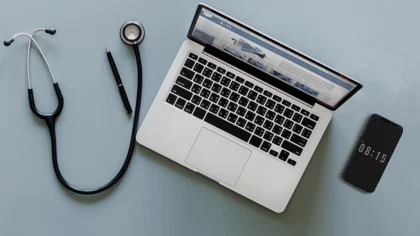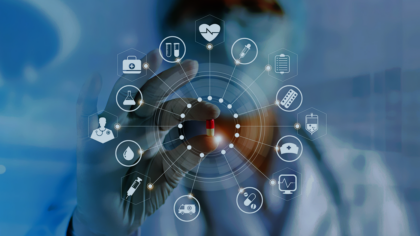Accelerate Productivity in 2025
Reignite Growth Despite the Global Slowdown
Executive Summary: What are the Top 10 Health & Fitness Industry Trends in 2026?
- Hyper-Personalization: Genomics, artificial intelligence (AI), and microbiome data enable tailored training and nutrition. The hyper-personalized fitness market is projected to surge to USD 26.16 billion by 2035 at a compound annual growth rate (CAGR) of 18.9%.
- Mental Health & Fitness Convergence: Integrated platforms combine physical exercise with stress and anxiety management. The global market for mental wellness apps is expected to exceed USD 298.42 billion by 2032 at a 7.4% CAGR.
- Virtual Fitness: Virtual reality (VR)/augmented reality (AR)-based fitness classes and platforms make immersive workouts mainstream. The global virtual fitness market is projected to hit USD 201 billion by 2033.
- Smart Exercise Equipment: AI-powered gym systems and connected machines deliver adaptive training programs. The market for smart fitness is projected to hit USD 137.3 billion by 2030, at a CAGR of 11.1%.
- Wearables & Health Monitoring: Biometric wearables track glucose, oxygen, and heart rate variability. The wearables market is set to cross USD 191.58 billion by 2032.
- Longevity & Anti-Aging: Biohacking, supplements, and regenerative therapies push performance and aging research forward. Total financing reached USD 8.49 billion across 331 deals.
- Sustainable & Ethical Wellness: Eco-conscious fitness products and ethical supplement sourcing shape consumer behavior. Governments also enforce stricter sustainability regulations. The EU Green Claims Directive requires fitness clubs and wellness businesses to substantiate environmental claims, such as eco gym or green facility.
- Wellness Tourism & Workplace Wellness: Corporate programs and destination retreats expand focus on holistic well-being. The global wellness tourism market is projected to grow to USD 2.05 trillion by 2034 at a 7.97% CAGR.
- Conversational AI: Voice-driven health assistants automate coaching, scheduling, and personalized feedback. The conversational AI in healthcare market is projected to reach USD 48.87 billion by 2030.
- Weight Management & Sleep Optimization: Digital platforms integrate nutrition, metabolic tracking, and sleep analysis. The global weight management market is projected to reach USD 298.66 billion by 2030.
Read on to explore each trend in depth – uncover key drivers, current market stats, cutting-edge innovations, and leading health & fitness innovators shaping the future.
Frequently Asked Questions
1. How is technology improving the health and fitness industry?
AI, wearables, and smart equipment deliver personalized training, real-time monitoring, and adaptive recovery. They improve performance, reduce injuries, and aid individuals in sustaining long-term wellness goals.
2. What is the scope of emerging health and fitness trends?
Health and fitness trends extend beyond gyms to homes, workplaces, and wellness tourism. They support preventive health, mental resilience, and sustainable lifestyle adoption across global populations.
3. How big is the health and fitness market?
The global health and fitness club market size is projected to grow to USD 202.78 billion by 2030, exhibiting a CAGR of 8.83%.
Methodology: How We Created the Health & Fitness Trend Report
For our trend reports, we leverage our proprietary StartUs Insights Discovery Platform, covering 7M+ global startups, 20K technologies & trends, plus 150M+ patents, news articles, and market reports.
Creating a report involves approximately 40 hours of analysis. We evaluate our own startup data and complement these insights with external research, including industry reports, news articles, and market analyses. This process enables us to identify the most impactful and innovative trends in the health & fitness industry.
For each trend, we select two exemplary startups that meet the following criteria:
- Relevance: Their product, technology, or solution aligns with the trend.
- Founding Year: Established between 2020 and 2025.
- Company Size: A maximum of 200 employees.
- Location: Specific geographic considerations.
This approach ensures our reports provide reliable, actionable insights into the health & fitness innovation ecosystem while highlighting startups driving technological advancements in the industry.
Innovation Map outlines the Top 10 Health & Fitness Trends & 20 Promising Startups
For this in-depth research on the Top Health & Fitness Trends & Startups, we analyzed a sample of 25 000+ global startups & scaleups. The Health & Fitness Innovation Map created from this data-driven research helps you improve strategic decision-making by giving you a comprehensive overview of the health & fitness industry trends & startups that impact your company.

Tree Map reveals the Impact of the Top 10 Health & Fitness Industry Trends in 2026
The health and fitness industry trends shaping 2026 show a strong shift toward personalization, digital adoption, and preventive wellness.
AI-powered insights and genomics-based programs drive hyper-personalization, while mental health integration changes how people approach fitness routines. Virtual platforms and smart exercise equipment extend access to home and remote fitness experiences.
Wearables, health monitoring, and sleep-focused tools bring continuous tracking into daily life. At the same time, longevity solutions, sustainable practices, and workplace wellness programs strengthen consumer demand for holistic well-being.
Conversational AI further enhances engagement, guidance, and motivation. This signals a future where the health and fitness market trends prioritize both performance and overall quality of life.

Global Startup Heat Map covers 25 000+ Health & Fitness Startups & Scaleups
The Global Startup Heat Map showcases the distribution of 25 000+ exemplary startups and scaleups analyzed using the StartUs Insights Discovery Platform. It highlights high startup activity in the United States and Western Europe, followed by India. From these, 20 promising startups are featured below, selected based on factors like founding year, location, and funding.

Want to Explore Health & Fitness Innovations & Trends?
Top 10 Emerging Health & Fitness Trends [2026]
1. Hyper-Personalization: 90% of Consumers Seek Tailored Products
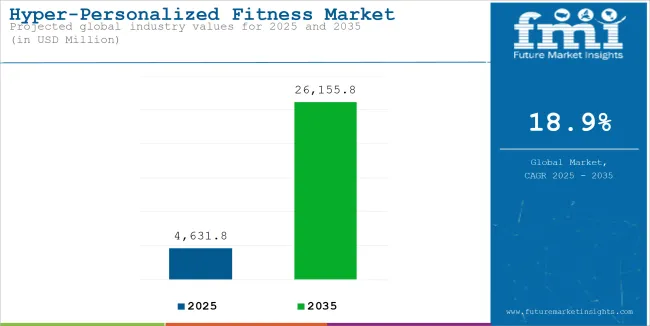
Credit: Future Market Insights
The hyper-personalized fitness market is projected to reach USD 4.63 billion in 2025 and is expected to surge to USD 26.16 billion by 2035 at a CAGR of 18.9%.
Consumer demand remains the strongest driver, as 85% of US and UK consumers think about their health daily, according to a new survey conducted by PA Consulting. Also, 90% seek tailored health products.
A McKinsey report states that telehealth utilization stabilized at levels 38x higher than before the pandemic. Moreover, between 40% and 60% of consumers express interest in a set of broader virtual health solutions, such as a digital front door or lower-cost virtual-first health plan.
Hyper-personalization improves treatment precision by aligning interventions with genetic, lifestyle, and biomarker data. For example, Johnson & Johnson offers oncology personalization by developing AI-powered biomarker tests. This solution detects genetic alterations from biopsy images to guide targeted therapies.
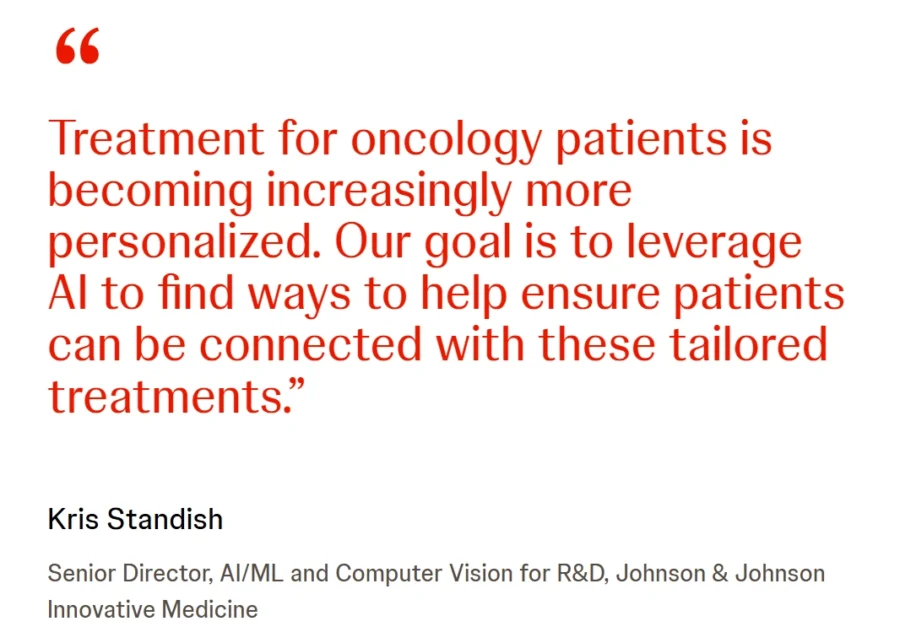
Credit: Johnson & Johnson
Personalization also extends deeply into nutrition, where companies like DNAFit and 23andMe offer gene-based nutrition and genetic testing for ancestry and health-related traits, respectively.
The Internet of Things (IoT) and wearable devices also expand hyper-personalization through continuous tracking of heart rate, glucose, and sleep patterns.
At the same time, big data analytics and cloud computing drive hyper-personalization by merging genomic, lifestyle, and clinical inputs into unified health profiles. For example, Glooko raised USD 100 million to offer data-driven diabetes management tailored to personal needs.
Meanwhile, real-time analysis for remote patient monitoring becomes possible through instant transmission of personalized health data, enabled by 5G and 6G connectivity.
AR and virtual reality VR further extend hyper-personalization into fitness and therapy. AR-powered fitness apps overlay real-time posture corrections, while VR platforms simulate adaptive training or rehabilitation environments. They adjust intensity based on user performance and recovery data.
Wellytics offers Genomics-informed Personalization Applications
Indian startup Wellytics develops an AI-driven healthcare platforms that integrate genomics, lifestyle factors, and blood parameters to provide hyper-personalized health insights. Its products include Veda, Ultra, XomePlus, and Xome.
Veda is a mobile AI health copilot that enables healthcare professionals to access personalized clinical decision support on the go. Ultra utilizes whole-genome sequencing (WGS) with polygenic risk score analysis, pharmacogenomics, and rare variant detection to provide a genetic assessment.
XomePlus offers exome sequencing with customizable panels, rare variant detection, and pharmacogenomics analysis. Lastly, Xome focuses on efficient whole-exome sequencing for protein-coding regions. This offers quick and accurate variant identification.
These AI-driven solutions also incorporate tools such as an integrated speech-to-text system, a temporal data reviewer, and a synopsis generator. It integrates with electronic medical records (EMRs) or hospital information systems.
This way, Wellytics’ solutions offer evidence-based recommendations and strengthen patient engagement. They also allow healthcare providers to implement preventive strategies that reduce the burden of chronic and lifestyle-related diseases.
CueZen deploys a Generative AI-powered Personalization Engine
US-based CueZen offers an AI-powered personalization engine, NudgeStream. It provides tailored health coaching to encourage behavior change and support chronic disease management.
NudgeStream integrates data from device sensors, self-reported measures, and clinical records to build personalized care pathways. Further, the startup’s proprietary AI-driven ranking framework, NudgeRank, selects the most relevant evidence-based cues for each user to guide timely health decisions.
CueZen also enables health enterprises to build custom conversational AI health coaches aligned with specific guidelines and protocols. The personalization engine connects with iOS and Google trackers, leverages existing AI risk scores, and maintains government-grade compliance.
2. Mental Health & Fitness Convergence: 38% YoY Investment Growth in 2024
The pandemic highlighted the importance of mental wellness as part of daily fitness and lifestyle routines. As a result, the mental wellness market expanded at an annual growth rate of 11.6% between 2019 and 2023. Moreover, investors increased this convergence by raising digital mental health venture capital investment by 38% in 2024.
At the same time, consumers are prioritizing mental wellness in their daily lives and seeking fitness platforms that address stress, anxiety, and recovery. Employers are also embedding mental wellness programs into corporate fitness and wellness strategies. These initiatives reduce absenteeism, improve retention, and lower healthcare costs.
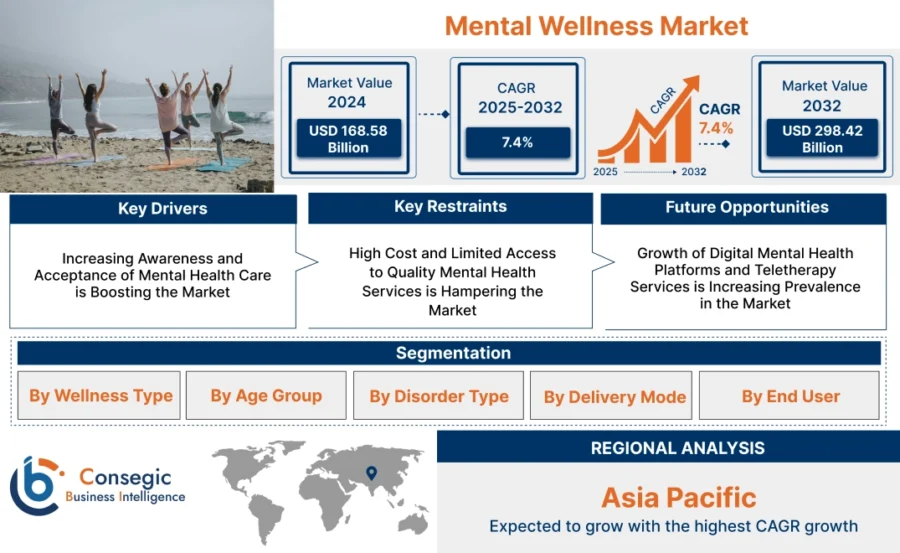
Credit: Consegic Business Intelligence
The global mental wellness market is expected to expand to USD 178.05 billion in 2025 and over USD 298.42 billion by 2032 at a 7.4% CAGR.
The mental health and fitness convergence produces measurable benefits. For example, a study shows that adults doing half the recommended weekly physical activity – about 4.4 MET-h/week or 2.5 hours of brisk walking. They had an 18% lower risk of developing depression. lower risk of developing depression. This compares to those reporting no activity (95% CI: 13%-23%).
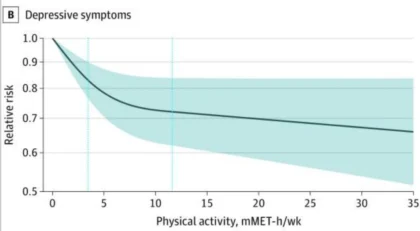
Credit: Public Medical Central
Also, programs that combine exercise with mindfulness achieve stronger anxiety reduction than either approach alone. National efforts, for instance, India’s Tele MANAS program, handled over 1.8 million mental health calls across 53 centers by 2025.
Moreover, enabling technologies drive this convergence. Wearable devices track sleep, stress, and recovery to connect physical performance with mental resilience. For example, Apple Watch, WHOOP, and Oura Ring provide continuous monitoring to guide stress management.
Extended reality (XR) enhances engagement by combining fitness and mindfulness in immersive experiences. XRHealth and Supernatural VR, for example, integrate stress relief into physical workouts to improve adherence.
Predictive analytics frameworks analyze complex physiological patterns to identify early warning signs of depression or anxiety. Cloud computing supports these frameworks by securely merging biometric and behavioral data from multiple devices. This enables real-time analysis that improves personalized interventions.
Strove offers a Physical Activity, Mental Wellness, and Nutrition App
South African startup Strove develops a data and AI-driven health platform that uses behavioral science and digital tools to improve physical, mental, and nutritional well-being.
The platform gathers data from well-being surveys, activity tracking, and lifestyle inputs. It analyzes this information to create actionable health insights and offer personalized recommendations for organizations, insurers, and individuals.
Moreover, the platform provides evidence-based mental health resources, including a library of audio, video, and written assets. It also provides global access to professional counselling and coaching, along with screening tools that track stress, sleep, mood, and nutrition.
HeadClear provides a Workplace Mental Health Wellbeing Platform
UK-based startup HeadClear creates a workplace mental health and wellbeing platform. It utilizes proprietary Insight Optical Imaging technology and machine learning (ML) to measure and improve employee mental health, resilience, and performance.
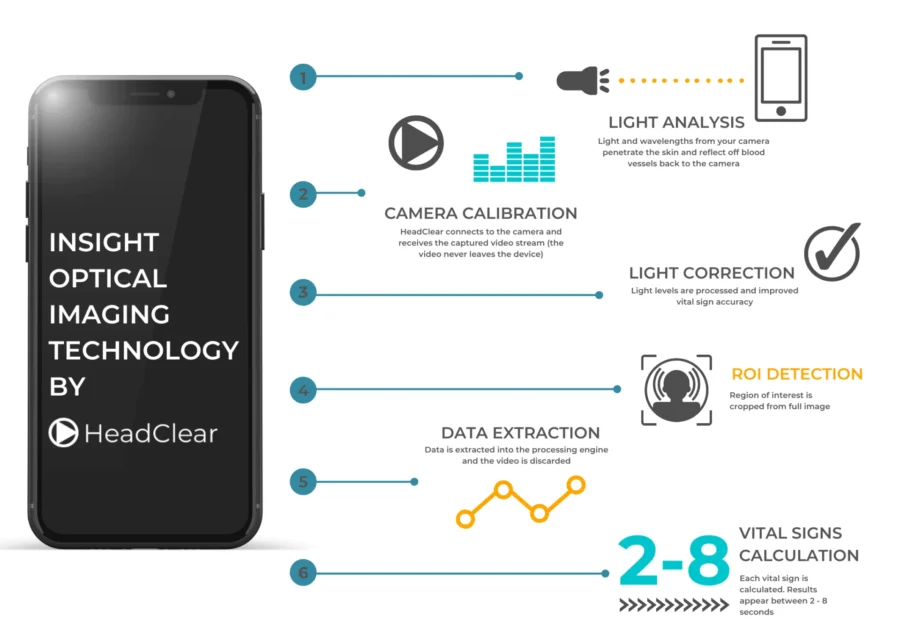
Credit: HeadClear
The platform maps facial blood flow to assess vital signs linked to well-being and stress. It also removes emotional bias from evaluations and combines this data with real-time tracking of how employees and managers handle workplace demands.
Moreover, the platform provides employees with personalized insights, well-being scores, and stress indexes. It also integrates forecasting tools to predict future mental health patterns in advance and drive preventative action.
3. Virtual Fitness: VR-Based Physiotherapy Shows 94% Adherence
The key drivers of virtual fitness adoption include heightened health consciousness and the rising focus on preventive care. According to the CDC, the prevalence of obesity among US adults aged 20 and over was 41.9% during the period from 2017 to March 2020. To address obesity, structured digital training delivers major support for healthier lifestyles.
Modern work patterns demand flexibility, and virtual platforms remove commuting, fixed schedules, and gym hour barriers by offering 24/7 on-demand access. On-demand fitness apps and VR-enabled platforms provide 24/7 access. This convenience allows users to train whenever and wherever they choose, as well as makes fitness more inclusive for working professionals, parents, and individuals in rural or underserved areas.
Virtual fitness delivers benefits that go beyond cost and convenience. A meta-analysis involving patients with multiple sclerosis (MS) found VR-based physiotherapy for balance and gait had adherence rates exceeding 94%.
Moreover, corporations such as Salesforce and Nike introduced virtual wellness programs to reduce absenteeism, strengthen retention, and lower healthcare costs.
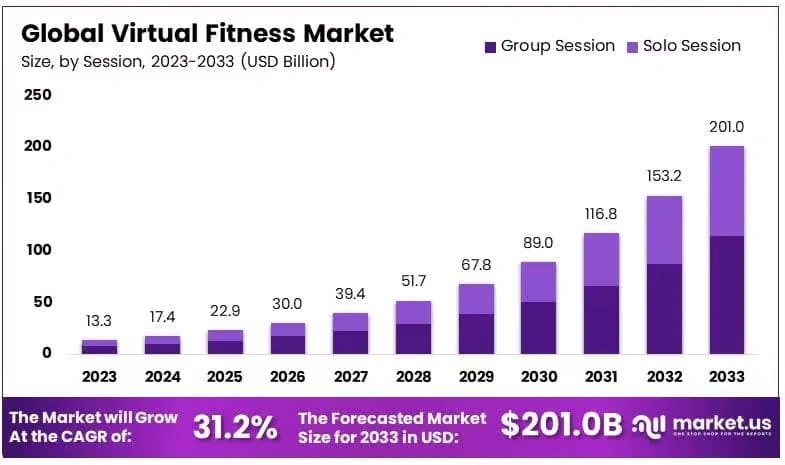
Credit: market.us
Additionally, the global virtual fitness market is expected to expand to USD 201.0 billion by 2033 at a CAGR of 31.2%.
AI- and ML-based solutions create hyper-personalized training plans, deliver real-time form correction, and guide adaptive recovery. Wearable devices track biometrics continuously and feed recovery and stress insights into virtual platforms.
Extended reality platforms like Supernatural VR and FitXR merge immersive environments with exercise routines and elevate engagement.
Further, computer vision improves posture recognition and prevents injuries by analyzing body movement through webcams or smartphone cameras. A noteworthy instance is that of Kaia.
Recent innovations and partnerships drive the growth in this segment. For instance, Barre3 and WHOOP offer combined biometric recovery data with digital workouts. Kabata also introduced the world’s first AI-powered dumbbells with USD 5 million in seed funding.
GrowGen develops an Immersive Virtual Fitness Platform
Australian startup GrowGen builds a virtual fitness platform that combines AR, AI, and 3D motion capture to create interactive workout experiences.
The platform tracks real-world activities through sensors and real-time motion capture. It then translates each user’s performance into measurable changes in the digital twin avatar, Avatron. It visually evolves to reflect fitness progress and achievements.
Additionally, the platform leverages AI to deliver fitness insights, set adaptive challenges, and provide precision feedback. It also integrates blockchain-secured health identities through the GenID system, which tokenizes real-world health data and rewards verified activity via its proof of health mechanism.
Moreover, it enables users to participate in AR-enhanced workouts, VR challenges, and virtual competitions. The platform also connects participants within the shared space by creating a community-driven fitness experience.
Goals.Fit offers a Virtual Race Platform
Indian startup Goals.Fit deploys a virtual fitness platform that enables individuals, clubs, and fitness organizations to create and manage virtual cycling, running, and walking challenges.
The platform allows participants to join via its mobile app or website and track activities through integration with GPS-enabled fitness devices and apps. It also receives automated rank updates every 15 minutes based on GPS-enabled workout data.
It gives organizers full administrative control to edit event details, manage participant lists, verify workouts, and set custom ranking criteria.
Moreover, the platform offers flexibility to host free or paid events, supports white-labeled registrations for branded experiences, and automates operations.
4. Smart Exercise Equipment: A >USD 7 B Market by 2030
Smart exercise equipment is moving beyond traditional machines by embedding AI, sensors, and connectivity into workouts. These systems respond to user performance in real time, adapt resistance automatically, and integrate with apps or wearables to deliver data-driven training. This shift reflects demand for precision training and flexibility, especially as fitness moves across gyms, homes, and corporate wellness spaces.
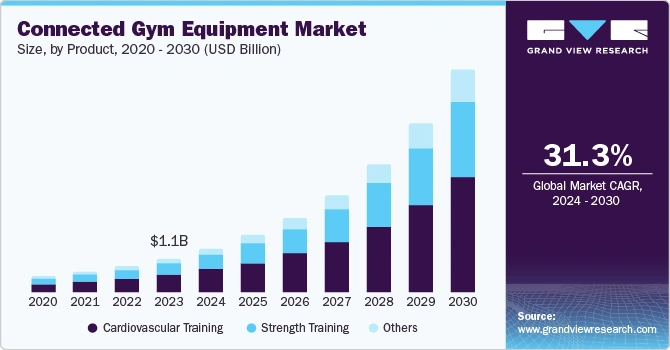
Credit: Grand View Research
The market outlook further pushes this shift. The connected gym equipment market is projected to reach USD 7 billion by 2030 at a CAGR of 31.3%.
Enabling technologies strengthen this growth trajectory. IoT frameworks connect fitness equipment to wearables, mobile apps, and cloud platforms for unified data flows. This allows users to monitor progress, adjust routines, and maintain consistent wellness goals.
Computer vision improves motion tracking. A noteworthy example is Tempo, which applies camera-based recognition to prevent injury during training.
Biometric sensors also measure heart rate variability, muscle oxygenation, and stress. These sensors provide medical-grade precision and strengthen the link between physical training and wellness. Moreover, voice recognition integrated into exercise machines creates hands-free, interactive coaching experiences tailored to each workout.
EGYM secured USD 200 million to scale its AI-driven machines, while Solidcore raised USD 325 million to expand its connected Pilates platform. These cases show how capital is fueling innovation in connected gym equipment.
Hiveact builds a Sensor-enabled Training Device
Greek startup Hiveact makes smart exercise equipment and a connected training platform that increases athletic performance through interactive reaction training.
Its starter kit includes innovative reaction lights and essential accessories that create drills to improve agility, speed, and perception.
Moreover, the companion app connects with these reaction lights and related training devices to provide interactive exercises and track performance metrics. It also delivers personalized workout suggestions based on user preferences and history.
The app allows users to monitor progress in real time, share results with trainers or teams, and manage multiple Hiveact devices.
AEKE develops an AI-enabled Smart Home Gym
Chinese startup AEKE offers smart exercise equipment that integrates AI, motion analysis, and immersive technology to deliver personalized home fitness experiences.
The company’s product, AEKE K1 Fitness Mirror, conducts a six-dimensional fitness assessment. It covers cardiovascular endurance, movement patterns, muscle strength, posture, flexibility, and body composition. Additionally, it analyzes the results to understand the user’s current fitness level. The fitness mirror then uses AI to create adaptive workout plans with over 280 movements and 160 guided classes.
The fitness mirror tracks performance in real time, detects form deviations, and provides instant corrective feedback through voice or visual prompts. Post-session reports offer detailed insights and targeted recommendations.
Moreover, the AEKE K1 Fitness Mirror features a 43-inch 4K touch display with surround sound for an immersive workout environment. It also includes gamified training modes and integrates with multiple accessories for varied strength and cardio exercises.
5. Wearables & Health Monitoring: Apple Heart Study Shows 84% PPV
Wearables and health monitoring are gaining traction as consumers shift from reactive treatment to proactive health management. Instead of waiting for clinical visits, individuals rely on devices to track vital signs, fitness performance, and recovery in real time.
Consumers adopt wearables both as lifestyle devices for fitness tracking and as medical-grade tools to monitor chronic conditions and support wellness management. They provide real-time insights that enable individuals to act before minor issues escalate into severe health events.
Continuous monitoring enables early detection of conditions such as atrial fibrillation and sleep apnea. It also allows users to incorporate preventive measures into daily fitness and recovery routines.
Personalized analytics convert patients into active participants who monitor goals, improve training, and make informed lifestyle choices.
For instance, the Apple Heart Study enrolled more than 400 000 Apple Watch users. Among those receiving an irregular rhythm notification, 34% had atrial fibrillation (AF) >30 seconds on ECG patch monitoring, and the algorithm showed an 84% positive predictive value (PPV) for concurrent AF.
Additionally, Cleveland Clinic applied wearables in pediatric cardiology. This integration enables continuous monitoring of infants with congenital heart disease outside intensive care units.
Credit: Towards Healthcare
The fitness tracker market is projected to expand to USD 71.92 billion in 2025 and USD 323.47 billion by 2034 at a CAGR of 18.04%.
Photoplethysmography (PPG) sensors measure heart rate, blood oxygen saturation (SpO₂), and stress. These sensors directly influence workout intensity and recovery decisions. Next-generation body composition analyzers assess muscle mass, fat, and hydration to offer athletes holistic performance metrics. Fall detection and emergency systems (SOS) extend protection for elderly users. These systems automatically contact caregivers or emergency services when abnormal motion patterns or impacts occur.
Sleep-tracking technologies provide actionable insights into rest quality. It allows fitness enthusiasts and patients to align recovery with performance goals. For instance, Oura, the company behind the world’s leading smart ring, announced the completion of a USD 200 million Series D funding round. Similarly, Ultrahuman in India raised USD 35 million to expand its competing wearable ecosystem.
YeyroRing manufactures Smart Rings for Health Monitoring
Australian startup YeyroRing provides a smart health ring that uses sensors and data analytics to deliver continuous health, fitness, and wellness monitoring.
The smart ring employs optical heart rate and SpO2 sensors, a temperature sensor, an accelerometer, and a gyroscope. It uses these components to track key metrics like heart rate variability, resting heart rate, blood oxygen, sleep quality, menstrual cycles, daily activity, and calories burned.
The smart ring integrates these measurements into a mobile app that provides health readiness scores, performance insights, and personalized guidance without a subscription.
Built with a rugged, waterproof design and an eight-day battery life, the ring offers durability and convenience for everyday wear, including during sleep and water-based activities.
GlaucoT provides a Wearable Noninvasive Glaucoma Treatment Device
Turkish startup GlaucoT offers a wearable medical device that offers noninvasive, home-based treatment for glaucoma.
The device targets both intraocular pressure and the neurodegenerative aspects of the disease. It also supports optic nerve health by applying controlled therapeutic stimulation that modulates neuroinflammatory pathways. This enables the calming of harmful microglial activation and preserves retinal ganglion cells.
The device provides controlled therapeutic stimulation that patients use regularly at home. This enables continuous management without frequent clinic visits.
Moreover, the wearable device tracks treatment adherence and patient progress, as well as gives clinicians valuable data to optimize care plans.

6. Longevity & Anti-Aging: A USD 120 B Market by 2030
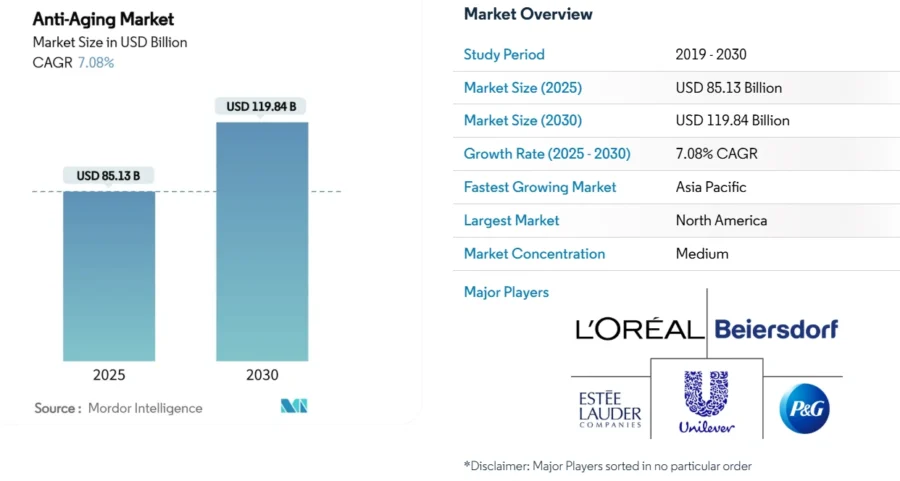
Credit: Mordor Intelligence
The global anti-aging market is projected to reach USD 85.13 billion in 2025 and is expected to grow to USD 119.84 billion by 2030 at a 7.08% CAGR. At the same time, the longevity sector is expected to expand to USD 63 billion by 2035, reflecting a 10.37% CAGR. This steady growth indicates how aging-related health solutions are becoming a vital focus across wellness, healthcare, and consumer markets.
Longevity and anti-aging solutions are growing as people live longer and chronic diseases increase. Consumers and healthcare systems are also shifting toward preventive care and healthy aging.
Governments promote healthy aging to reduce long-term healthcare costs. For instance, the European Union’s Horizon 2020 program facilitated collaborative R&D projects between universities, research institutes, and beauty companies. These partnerships led to developments in anti-aging treatments.
Employers integrate longevity-focused wellness into corporate programs to lower absenteeism and strengthen workforce retention. This shift creates momentum for innovations in healthy aging. For example, Biongevity launched AI-powered longevity app in 2024. The app uses facial scans to track blood pressure and heart rate in real time. This enables proactive lifestyle adjustments.
Longevity resorts such as SHA Spain, Canyon Ranch, and Six Senses provide biomarker testing, functional medicine, and recovery-based fitness.
On the other hand, senolytic therapies and nicotinamide adenine dinucleotide (NAD+) precursors intervene at the cellular level. These solutions reduce inflammation and increase mitochondrial function. Beiersdorf, for example, partnered with Rubedo Life Sciences to co-develop senolytic skincare.
Regenerative medicine techniques, such as stem cell therapy, tissue reprogramming, and tissue engineering, expand treatment options for repairing age-related damage.
Genetic testing and epigenetic profiling provide individualized longevity strategies tailored to biological markers.
Connected fitness ecosystems such as Peloton, Strava, and MyFitnessPal integrate recovery-focused protocols and AI-driven coaching. These solutions make longevity measurable in everyday routines.
MobiGym provides Personalized Longevity and Performance Training
Luxembourg-based startup MobiGym builds longevity-focused fitness and wellness programs by combining AI-powered training systems with individualized exercise and recovery plans.
It integrates the AI-powered CAROL Bike, which uses cardiovascular optimization logic to improve heart health. Its adaptive resistance system adjusts in real time to build strength and prevent muscle loss.
The startup combines these with complementary solutions, which include whole-body vibration therapy and photobiomodulation for muscle recovery and joint health. It also offers blood flow restriction training and VR-enhanced workouts for cognitive and physical benefits.
Moreover, the startup conducts science-based assessments to measure biological age and functional health markers. It then creates tailored plans that target aging biomarkers and promote long-term vitality.
Quelliv offers Laser Therapy, Anti-Aging, and Wellness Treatments
US-based startup Quelliv creates longevity and anti-aging solutions through low-level laser therapy (LLLT) using Genesis One lasers.
It applies photobiomodulation to direct specific wavelengths of light into targeted tissue. Photons stimulate mitochondrial activity, improve cellular metabolism, and promote protein, collagen, and adenosine triphosphate (ATP) production.
This process improves circulation, reduces inflammation, and restores cellular function without surgery, drugs, or downtime. The non-invasive treatments improve skin rejuvenation, including wrinkle reduction, acne management, and scar healing.
7. Sustainable & Ethical Wellness: EU Requires Proof for Eco Wellness Claims
Consumers link personal health with planetary well-being, which pushes wellness brands to prioritize eco-friendly sourcing, fair labor, and carbon footprint reduction.
Governments also enforce stricter sustainability regulations. In the European Union, new legislation called the EU Green Claims Directive was adopted in 2024. It is expected to require fitness clubs and wellness businesses to substantiate any environmental claims they make, such as “eco gym” or “green facility.”
Employers are embedding responsible wellness programs into corporate strategies to reduce costs and improve retention. Kyan Health raised USD 12.7 million to expand its corporate wellness platform, which allows companies to link employee well-being with environmental and social goals. It does so by using the funding to integrate ESG benchmarks into employee health programs and reporting.
Sustainable and ethical wellness solutions also strengthen trust, extend loyalty, and improve both environmental and personal health outcomes. For example, Adidas x Parley used recycled ocean plastics in running shoes. Also, Himalaya Wellness uses ayurvedic products with sustainable packaging.
Renewable energy systems such as solar-powered gyms and energy-harvesting treadmills lower emissions and operating costs. SportsArt’s ECO-POWR series, for instance, converts workout energy into reusable electricity, directly feeding into local grids.
Further, emerging startups are offering circular products such as biodegradable yoga mats, refillable wellness items, and modular gym systems. A noteworthy example is that of Terra Hale. It is a net-positive energy gym that is powered by human-generated electricity.
Blockchain-based supply chain platforms also enable transparent sourcing of wellness products. These platforms verify claims around organic ingredients or ethical labor.
Likewise, resorts such as SHA Spain and Six Senses integrate renewable energy systems, organic dining, and biomarker-driven recovery programs to link personal wellness with planetary health. These solutions embed environmental responsibility into wellness practices.
KUPA Station promotes Eco-Responsible Hydration
Canadian startup KUPA Station provides sustainable and ethical wellness solutions through a hydration platform. It combines healthy drinking water with integrated workplace communication tools.
The hydration platform uses natural ingredients extracted from real fruits and plants to create water in multiple flavors. It also eliminates the need for single-use containers to reduce environmental impact.
The hydration platform features a built-in digital display that enables organizations to share company updates, wellness tips, and real-time alerts. This offers high visibility in commonly accessed spaces.
Additionally, its digital ecosystem allows users to manage settings, monitor performance, and schedule maintenance from any connected device.
KUPA Station merges eco-friendly hydration with interactive engagement to promote employee well-being, corporate sustainability goals, and workplace communication.
Brownbag Protein provides Ethically‑Sourced Protein Formulations
UK-based startup Brownbag Protein formulates sustainable fitness supplements that align personal health goals with environmental responsibility.
It produces whey and vegan protein powders using ethically sourced ingredients such as raw cacao and pea protein. The startup also offers creatine supplements formulated for strength and recovery.
The products contain no artificial additives, maintain low sugar and carbohydrate content, and provide high protein levels to support muscle growth and maintenance.
All packaging, from resealable brown bags to shipping materials, is fully recyclable and free from plastic scoops.
8. Wellness Tourism & Workplace Wellness: A USD 2.05 T Market by 2034
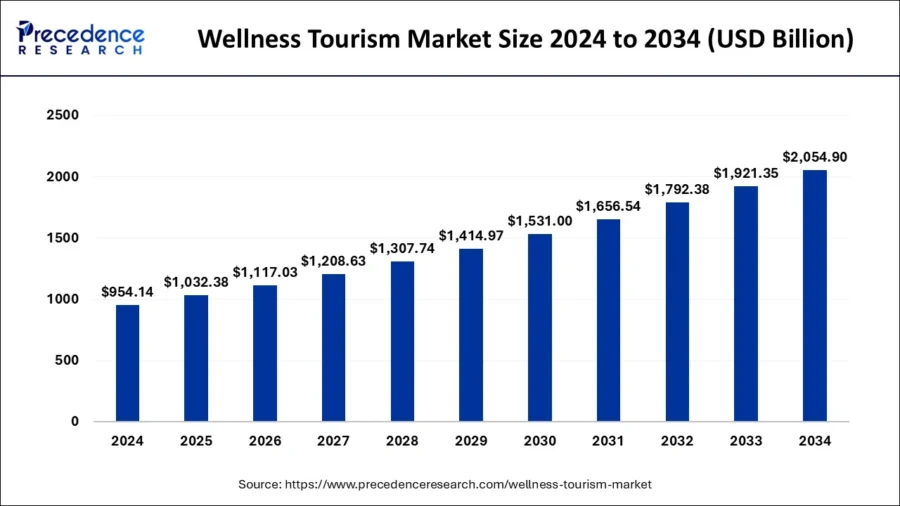
Credit: Precedence Research
The wellness tourism sector is projected to grow to USD 2054.90 billion by 2034 at a 7.97% CAGR. Also, workplace wellness is expected to rise to USD 124.3 billion by 2034 at a 7.2% CAGR.
Post-pandemic health consciousness, a stronger focus on mental wellness, and rising demand for preventive health solutions are driving this growth. A systematic review found that medical costs fell by about USD 3.27 on average for every dollar spent on wellness programs. Additionally, absenteeism-related costs decreased by around USD 2.73 per dollar invested.
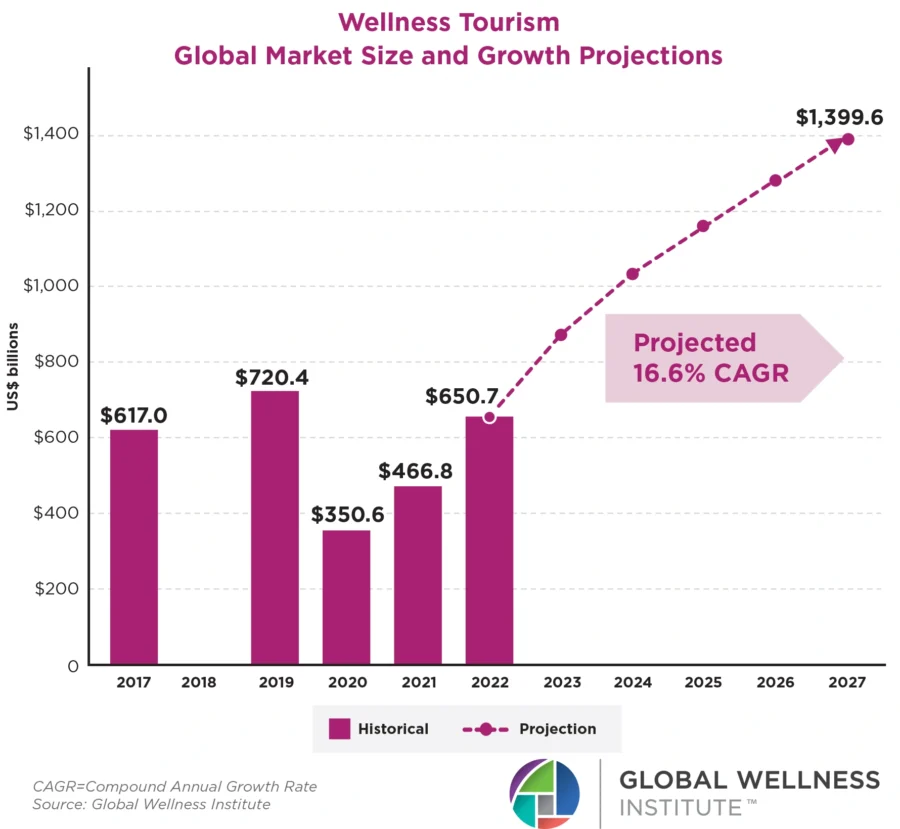
Credit: Global Wellness Institute
At the same time, wellness travelers seek authentic, sustainable, and culturally immersive experiences. International wellness tourists spent an average of USD 1764 per trip, which is 41% more than the typical international tourist. For example, EaseMyTrip invested INR 60 crore in The Wellness Co. to expand into health tourism.
Wellness travel initiatives improve physical fitness, reduce stress, and enhance sleep quality and energy levels. Workplace wellness programs also reduce the healthcare costs of companies and result in lower absenteeism rates. For example, Johnson & Johnson saved USD 250 million in healthcare costs over 10 years through its corporate wellness strategy.
Moreover, Naturoville Wellness in India combines Ayurvedic detox therapies with corporate retreats. They blend medical-grade supervision with holistic wellness.
Hotels and retreats use predictive analytics to recommend treatments. Likewise, companies apply AI-driven wellness platforms to monitor employee health metrics and improve nutrition or recovery plans.
Additionally, Hilton has integrated Calm’s guided meditations, sleep stories, soundscapes, and mindfulness exercises into its Connected Room Experience.
Spa and hydrothermal technologies further enhance wellness tourism experiences, where resorts offer automated cryotherapy, infrared saunas, and hydrothermal circuits to deliver consistent therapeutic outcomes. In workplace wellness, companies sponsor access to similar treatments through partnerships with external wellness providers rather than installing them on-site.
Visutate creates XR Spatial Computing-based Mental Wellness Experiences
US-based startup Visutate develops immersive VR nature experiences and AI-powered wellness coaching to address workplace stress and improve employee well-being.
The startup combines four-minute multisensory virtual environments, such as forests, underwater scenes, and cosmic landscapes, with research-backed relaxation techniques. These experiences trigger immediate stress reduction without disrupting workflow.
Additionally, it integrates 24/7 AI wellness experts trained by licensed therapists and executive coaches. These experts provide confidential, professional-grade guidance on stress management, productivity, and leadership challenges.
The startup enables organizations to reduce stress-related costs, increase employee satisfaction, and encourage healthier, more focused work environments.
Live Once Group facilitates Wellness-focused Travel Booking and Planning
UK-based startup Live Once Group creates technology platforms that act as a marketplace. It links users to wellness-focused travel options, curated experiences, and workplace well-being solutions.
Through its Walk Run Cycle app, the startup offers curated self-guided walking, running, and cycling routes in multiple cities. This encourages active exploration for tourists and business travelers.
Further, it’s BecauseYolo.Travel platform provides expert-written reviews, tips, and booking services for wellness retreats. BecauseYolo.Health offers at-home DNA testing kits that generate personalized reports to guide informed lifestyle decisions.
Moreover, its Wellness Concierge service supports corporate clients in enhancing employee wellness programs. It does so by arranging access to wellness retreats, fitness activities, and personalized health services tailored to workforce needs.
9. Conversational AI: A USD 48.87 B Market by 2030
The global conversational AI healthcare market is projected to reach USD 48.87 billion by 2030 at a CAGR of 23.84%.
Rising demand for personalized healthcare and fitness solutions remains the primary driver of adoption. Modern patients and fitness enthusiasts turn to conversational AI for individualized guidance, as these systems deliver real-time and adaptive coaching.
Healthcare providers also seek operational efficiency amid mounting cost pressures. Conversational AI enables scheduling, billing, and intake by streamlining workflows while reducing overhead. For instance, Medchat.ai allows providers to avoid 10 000 calls per month and save USD 9 million annually by deploying conversational automation.
Major disease prevalence and aging demographics increase demand for continuous support. AI systems provide continuous monitoring, reminders, and early warnings that traditional models cannot match. For example, EmpowerHealth integrates conversational AI for chronic disease management. It also reduces readmissions through daily engagement.
Conversational AI improves accessibility by offering round-the-clock, instant responses. It answers questions, provides guidance, and triages concerns at any hour. For example, K Health uses AI-powered chat to give patients immediate, evidence-based advice drawn from millions of records.
Moreover, by analyzing biometric and behavioral data, conversational AI tailors workout plans, recovery strategies, and treatment adherence.
Conversational AI also expands mental health access. Youper, for example, engages users in empathetic, evidence-based conversations. It offers real-time emotional support and mood tracking that complements therapy.
NLP and large language models (LLMs) provide context-aware, human-like interactions. For example, Abridge, adopted by Mayo Clinic and Kaiser Permanente, uses NLP to convert clinician-patient conversations into structured notes.
Automatic speech recognition (ASR) also offers hands-free voice interactions in clinical and home settings. Likewise, wearable integration and IoT sensors feed real-time biometric data into conversational systems.
Strategic alliances also shape this growth. For example, the OpenAI Startup Fund, Thrive Global, and the Alice L. Walton Foundation launched Thrive AI Health to create AI-powered personal health coaches for sleep, stress, fitness, and nutrition.
At a community level, London Sport’s collaboration with Satisfi Labs applies conversational AI across 3000+ organizations to make physical activity more accessible.
Movebite provides a Conversational AI Health Coach
Movebite is a Dutch startup that provides an AI-powered health coach. It provides personalized micro-coaching to employees through Slack and Microsoft Teams to improve movement, focus, and overall well-being during the workday.
The AI-powered health coach integrates directly with existing communication tools and employee calendars to send smart, context-aware reminders without disrupting workflows.
It offers office-friendly movement suggestions, expert-led live sessions, and workshops that require no special equipment.
The startup uses real-time conversational AI guidance and evidence-based health recommendations to address workplace issues such as back, neck, and shoulder pain. This reduces absenteeism and enhances productivity through sustainable, healthy work habits.
ONVY HealthTech Group offers AI Health Coach as a Service
German startup ONVY HealthTech Group provides an AI-powered health coaching engine with hyper-personalized modules for nutrition, fitness, recovery, sleep, stress, and longevity. These modules engage users and improve retention.
It also offers a business intelligence dashboard that analyzes behavioral and demographic trends, supports continuous optimization, and provides actionable insights for organizations.
Moreover, the platform aggregates data from health sources. This includes wearables, laboratory tests, lifestyle inputs, and environmental signals.
It also processes this data through a unified application processing interface (API) and standardizes it in real time. This enables easy integration into client ecosystems.
10. Weight Management & Sleep Optimization
Increasing obesity rates, the surge in sleep disorders, and the growth of lifestyle-related chronic diseases drive the adoption of weight management and sleep optimization solutions.
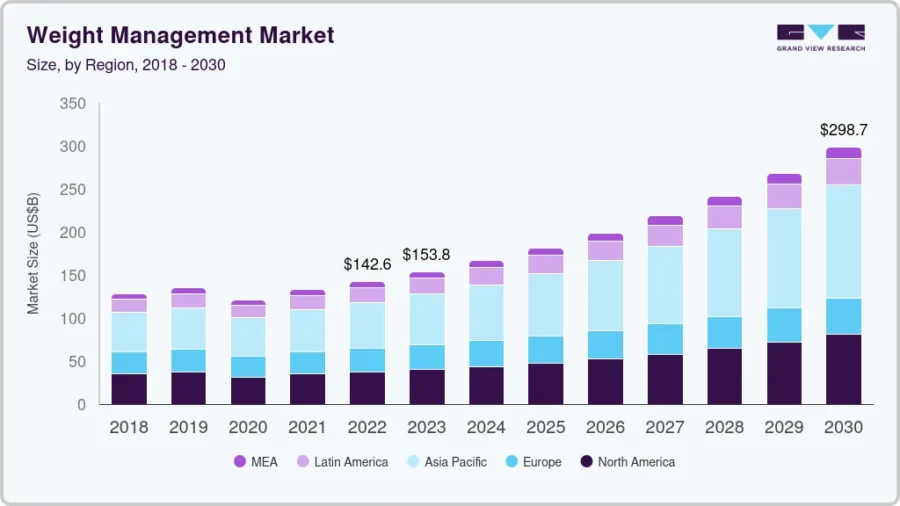
Credit: Grand View Research
With obesity rates rising worldwide, the global weight management market is projected to reach USD 298.66 billion by 2030 at a CAGR of 9.94%.
Consumers recognize the link between poor sleep and weight gain, so they pursue programs that combine nutrition, fitness, and recovery into personalized routines. Employers are also offering corporate wellness initiatives that connect stress management with sleep improvement and weight control to reduce absenteeism and healthcare costs.
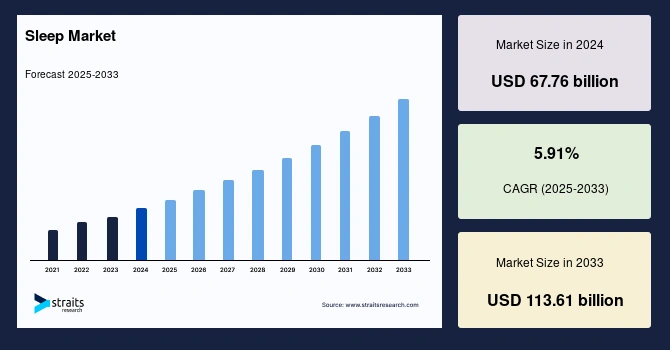
Credit: Straits Research
The global sleep market size is anticipated to grow from USD 71.77 billion in 2025 to USD 113.61 billion by 2033, exhibiting a CAGR of 5.91% during the forecast period 2025-2033.
Healthcare providers expand adoption through telemedicine and digital health platforms that integrate behavioral coaching, glucagon-like peptide-1 (GLP-1) weight-loss drugs, and remote monitoring.
For instance, the Noom weight loss program utilizes cognitive behavioral therapy (CBT) to address habits in weight management. Likewise, Omada Health combines connected devices with behavioral support to prevent obesity and diabetes.
Wearables deliver biometric insights, as they track sleep stages, caloric expenditure, and heart rate variability. AI analyzes these data streams to deliver real-time recommendations. For example, Eight Sleep‘s AI-powered smart mattress regulates temperature and improves sleep quality.
Genetic and epigenetic profiling extend personalization, as InsideTracker provides diet and circadian rhythm optimization strategies.
IoT also improves home environments for sleep improvement. For example, Philips Hue and Google Nest devices adjust light and temperature to align with circadian health. Further, neurotechnology innovations advance sleep monitoring through electroencephalography (EEG)-based headbands, while audio-based systems enhance sleep depth and efficiency.
GLP-1 receptor agonists, like semaglutide and tirzepatide, combine with digital coaching platforms to ensure adherence. Eli Lilly, for example, collaborates with digital health providers to extend GLP-1 therapy delivery.
Additionally, longevity resorts incorporate sleep labs, recovery-based fitness, and nutritional programs. They embed weight and sleep optimization into lifestyle-based wellness experiences.
Gaya Wellness creates a Virtual Weight Management Platform
US-based startup Gaya Wellness develops a medically guided weight management program using GLP-1 medications such as semaglutide and tirzepatide. It allows women to address hormonal, metabolic, and lifestyle challenges to weight loss during perimenopause and menopause.
The program starts with a virtual consultation with board-certified physicians. They review medical history, order lab work, and customize medication dosing for each participant.
It combines GLP-1 therapy with personalized coaching, nutrition planning, and biometric tracking. This reduces cravings, improves insulin response, and regulates appetite through mechanisms like slowed gastric emptying.
The service also includes sleep optimization by targeting metabolic and hormonal factors that disrupt rest. It offers strategies to improve recovery and energy levels alongside weight management.
Ruablab builds a Sleep Analysis Device and Application
Ruablab is a South Korean startup that offers a personal sleep wellness device and companion app that analyzes and manages sleep quality through advanced respiratory monitoring.
The wellness device, RUAH, uses high-sensitivity sensors and motion detection to capture detailed breathing patterns, detect sleep apnea, and monitor movements such as tossing and turning.
Its AI-powered algorithms process this data to generate real-time insights and detailed daily reports. This includes respiratory rate, snoring, and sleep patterns.
The lightweight, ergonomically designed device incorporates medical-grade silicone for comfort and connects via a C-type port for convenient charging.
Through continuous monitoring and user-friendly analysis, the startup enables individuals to address sleep disorders, improve rest quality, and support wellness. This contributes to better recovery, energy balance, and weight management.
Discover all Health & Fitness Trends, Technologies & Startups
The future of the health and fitness industry will be shaped by biotechnology, AI-driven diagnostics, and robotics that improve performance, recovery, and care delivery. Emerging innovations, like blockchain-enabled supplement tracking, bioengineered recovery tools, and sensor-based biomechanics, are expected to bring new levels of accuracy and personalization.
As lifestyles evolve and global health demands rise, staying ahead means looking beyond conventional fitness models. The next wave of health and fitness industry trends is projected to impact how we monitor, train, and sustain wellness, from the cellular level to community-wide health ecosystems.
The Health & Fitness Trends & Startups outlined in this report only scratch the surface of trends that we identified during our data-driven innovation & startup scouting process. Identifying new opportunities & emerging technologies to implement into your business goes a long way in gaining a competitive advantage.
![Discover the Top 10 Health and Fitness Industry Trends & Innovations [2026]](https://www.startus-insights.com/wp-content/uploads/2025/08/HealthFitness-Industry-Trends-SharedImg-StartUs-Insights-noresize-420x236.webp)


![Discover the Top 10 Recent Trends in Laser Technology [2026]](https://www.startus-insights.com/wp-content/uploads/2025/08/Recent-Trends-in-Laser-Technology-SharedImg-StartUs-Insights-noresize-420x236.webp)
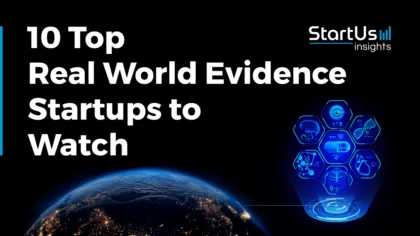
![Dive into the Top 10 Innovations and Trends in Medical Research [2026]](https://www.startus-insights.com/wp-content/uploads/2025/07/Trends-in-Medical-Research-SharedImg-StartUs-Insights-noresize-420x236.webp)
